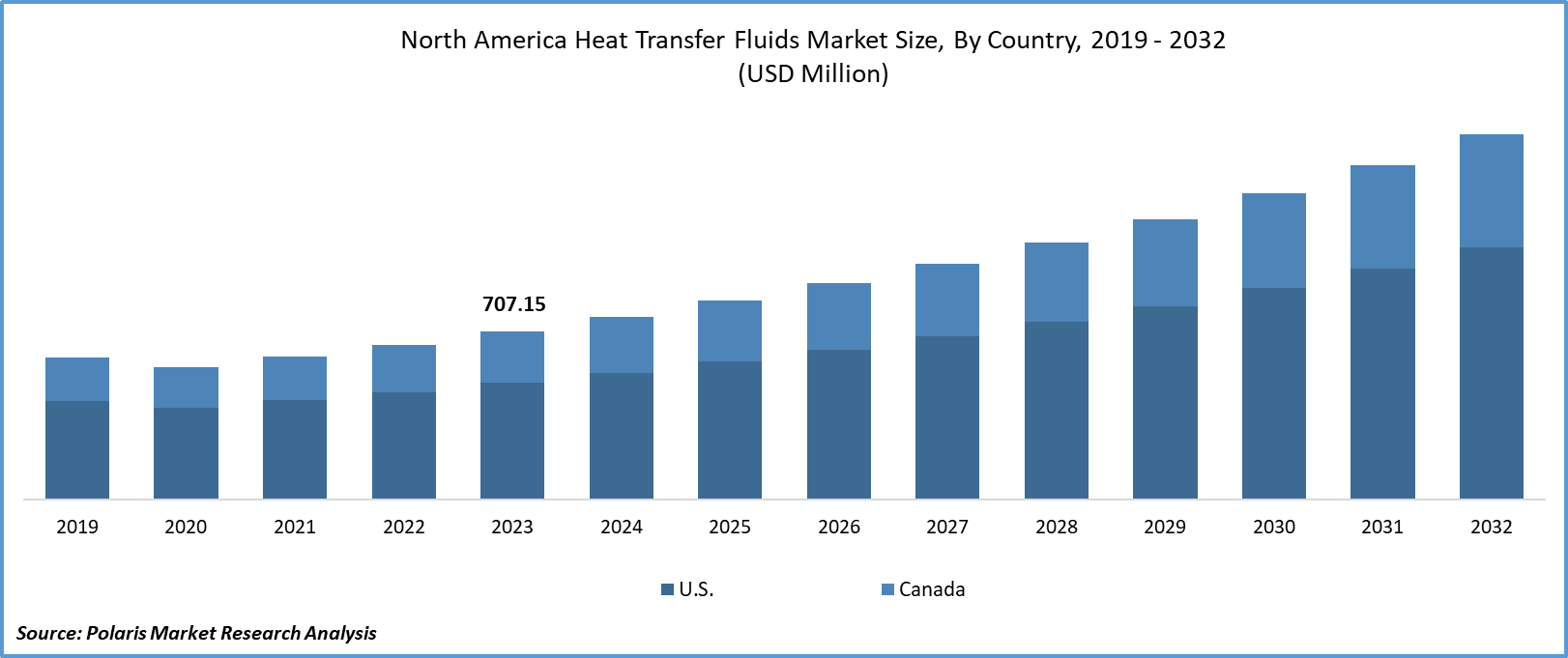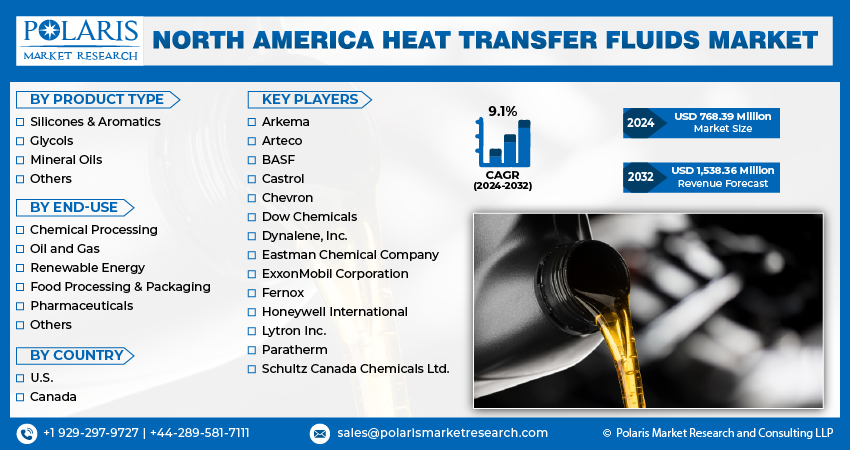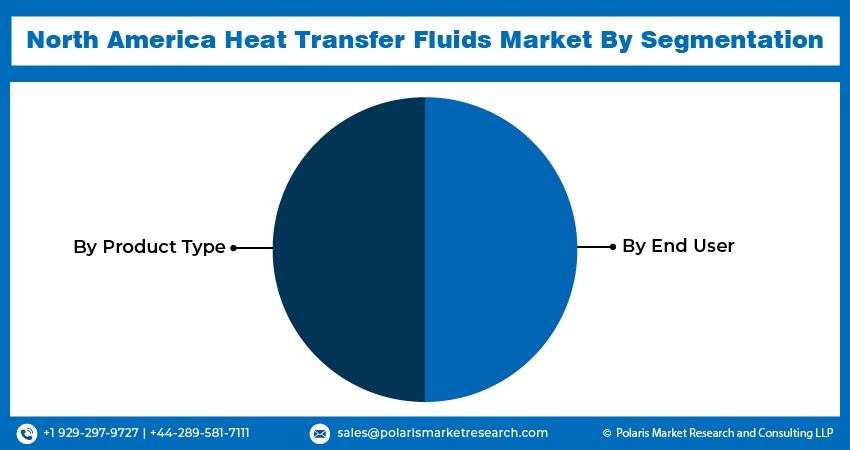
North America Heat Transfer Fluids Market Share, Size, Trends, Industry Analysis Report, By Product Type (Silicones & Aromatics, Glycols, Mineral Oils, Others); By End-Use; By Country; Segment Forecast, 2024 - 2032
- Published Date:Mar-2024
- Pages: 119
- Format: PDF
- Report ID: PM4471
- Base Year: 2023
- Historical Data: 2019-2022
Report Outlook
The north america heat transfer fluids market size was valued at USD 707.15 million in 2023. The market is anticipated to grow from USD 768.39 million in 2024 to USD 1,538.36 million by 2032, exhibiting the CAGR of 9.1% during the forecast period.
Industry Trends
The market is expected to grow significantly in the global industry, with a rising demand for efficient heat transfer solutions. Various factors, such as rising demand for HVAC systems and the need for energy-efficient processes, drive the market. In addition, the shift towards renewable energy sources and the increasing focus on reducing carbon emissions are also expected to drive the growth of the market in North America.
One of the primary drivers of the North American heat transfer fluids market is the increasing demand from various industries such as chemical processing, oil and gas, and power generation. These industries need heat transfer fluids to maintain optimal temperatures and ensure efficient operations. Also, the growing trend of using heat transfer fluids in solar thermal systems and geothermal applications is expected to contribute to the market's growth.

To Understand More About this Research: Request a Free Sample Report
However, factors such as fluctuating raw material prices affect the production costs and profitability of manufacturers. The availability of substitute products, such as steam and water-based systems, also poses a threat to the adoption of heat transfer fluids.
Key Takeaways
- The U.S. dominated the market and contributed over 67% of the share in 2023
- By product type category, the glycols segment accounted for the largest market share in 2023
- By end-use category, the oil and gas segment led the North American market in 2023
What are the market drivers driving the demand for North America heat transfer fluids market?
The growing need for efficient heat transfer fluids drives market growth.
As industries strive to improve their manufacturing processes, they require more effective coolants and lubricants that can withstand high temperatures without breaking down or losing their properties. This is particularly important in sectors such as automotive, chemical processing, and oil refining, where equipment must operate at peak efficiency to maintain productivity and minimize downtime. By using advanced heat transfer fluids, businesses may decrease maintenance costs, increase output, and extend the life of their machinery.
Further, the use of high-performance heat transfer fluids allows firms to run their operations at higher temperatures, which can lead to improved quality products and greater yields. Overall, the need for enhanced heat transfer solutions is an essential factor driving the expansion of the North American market.
Which factor is restraining the demand for heat transfer fluids?
The high cost of raw materials and production processes hinder the market.
The fluctuation in raw material prices significantly impacts the production costs and profitability of manufacturers, which acts as a restraining factor for the North America Heat Transfer Fluids market. The prices of raw materials such as mineral oil, synthetic oils, and water-based fluids can vary due to factors like global demand, supply chain disruptions, and geopolitical tensions. When raw material prices increase, manufacturers may struggle to maintain their profit margins while keeping their product prices competitive. This leads to decreased investment in research and development, reduced production levels, or even plant closures.
Also, price volatility makes it challenging for companies to predict future costs and plan their operations effectively, creating uncertainty and instability in the market. As a result, fluctuations in raw material prices can hinder the growth of the North America Heat Transfer Fluids market.

Report Segmentation
The market is primarily segmented based on product type, end-use, and country.
|
By Product Type |
By End-Use |
By Country |
|
|
|
To Understand the Scope of this Report: Speak to Analyst
Category Wise Insights
By Product Type Insights
Based on product type analysis, the market is segmented on the basis of silicones & aromatics, glycols, mineral oils, and others. In 2023, glycol-based heat transfer fluids accounted for the largest share of the North American market owing to their excellent performance, versatility, and cost-effectiveness. Glycols are widely used in various industries, such as HVAC, chemical processing, and oil & gas, where efficient heat transfer is important. They have a high boiling point, low viscosity, and good thermal conductivity, making them ideal for use in applications that require efficient heat transfer.
In addition, glycols are relatively inexpensive compared to other types of heat transfer fluids, which makes them a cost-effective option for many industrial users. Also, advancements in technology have led to the development of various types of glycols that can cater to specific application requirements, such as ethylene glycol, propylene glycol, and glycerin.
By End-Use Insights
Based on end-use analysis, the market has been segmented on the basis of chemical processing, oil and gas, renewable energy, food processing & packaging, pharmaceuticals, and others. The market was led by the oil and gas sector in 2023, owing to the increasing demand for efficient and reliable heat transfer solutions in the production and transportation of oil and natural gas. The extraction, processing, and refining of these hydrocarbons require high-performance heat transfer fluids that can withstand extreme temperatures and pressures, making them an essential component in the industry.
Along with this, the growing demand for liquefied natural gas (LNG) and compressed natural gas (CNG) has further driven the need for specialized heat transfer fluids that can efficiently handle the low temperatures required for liquefaction and compression processes. As a result, the oil and gas segment accounted for a significant share of the market in 2023, with prominent players such as Dow, BASF, and Eastman Chemical Company offering a range of products catering to this application area.

Country-wise Insights
United States
The United States held the largest revenue share in the North American heat transfer fluids market in 2023 owing to the country's well-established manufacturing sector, with a strong presence of key players in the heat transfer fluids industry, such as Dow, ExxonMobil, and Chevron. These companies have extensive production facilities and distribution networks across the country, enabling them to cater to the growing demand for heat transfer fluids from various industries, including chemical processing, oil and gas, and HVACR. In addition, the U.S. is home to some of the world's leading technology and research institutions, which drives innovation and advancements in heat transfer fluid technologies, further boosting the market growth.
Also, the country has implemented stringent regulations regarding energy efficiency and environmental safety, which has led to an increased adoption of high-performance heat transfer fluids that are more efficient and environmentally friendly. All these factors combined have contributed to the U.S.'s dominant position in the North American market.
Competitive Landscape
The North American heat transfer fluid market is dominated by a few major players, including Dow, ExxonMobil, and Chevron. These companies are involved in various activities such as research and development, production, and distribution of heat transfer fluids. They offer a range of products with different properties to cater to diverse applications across industries like chemical processing, oil and gas, power generation, and HVACR. These companies also invest in R&D to develop new and improved heat transfer fluids that meet the evolving needs of their customers.
Some of the major players operating in the North American market include:
- Arkema
- Arteco
- BASF
- Castrol
- Chevron
- Dow Chemicals
- Dynalene, Inc.
- Eastman Chemical Company
- ExxonMobil Corporation
- Fernox
- Honeywell International
- Lytron Inc.
- Paratherm
- Schultz Canada Chemicals Ltd.
Recent Developments
- In September 2022, Hydratech, a U.K. company that formulates and manufactures high-performance glycols, heat transfer fluids, and water treatment chemicals, opened its first U.S. site in Connecticut, United States. This new production facility and office space allowed the company to introduce its industry-proven products and services to the American markets of refrigeration and air conditioning (RAC), heating, ventilation, and air conditioning (HVAC), and renewable energy.
- In April 2023, Arteco launched heat transfer fluids named Zitrec® EC, which is a range of direct-to-chip coolants for data center cooling and electronics.
Report Coverage
The North America Heat Transfer Fluids market report emphasizes on key countries across the region to provide better understanding of the product to the users. Also, the report provides market insights into recent developments, trends and analyzes the technologies that are gaining traction around the globe. Furthermore, the report covers in-depth qualitative analysis pertaining to various paradigm shifts associated with the transformation of these solutions.
The report provides detailed analysis of the market while focusing on various key aspects such as competitive analysis, product type, end-use, and their futuristic growth opportunities.
Heat Transfer Fluids Market Report Scope
|
Report Attributes |
Details |
|
Market size value in 2024 |
USD 768.39 million |
|
Revenue forecast in 2032 |
USD 1,538.36 million |
|
CAGR |
9.1% from 2024 – 2032 |
|
Base year |
2023 |
|
Historical data |
2019 – 2022 |
|
Forecast period |
2024 – 2032 |
|
Quantitative units |
Revenue in USD million and CAGR from 2024 to 2032 |
|
Segments covered |
By Product Type, By End-use, By Country |
|
Regional scope |
U.S., Canada |
|
Customization |
Report customization as per your requirements with respect to countries, region and segmentation. |
FAQ's
key companies in North America Heat Transfer Fluids Market are Arkema, BASF, Castrol, Chevron, Dow Chemicals, Dynalene, Inc., Eastman Chemical Company, ExxonMobil Corporation
North America Heat Transfer Fluids Market exhibiting the CAGR of 9.1% during the forecast period.
The North America Heat Transfer Fluids Market report covering key segments are product type, end-use, and country.
key driving factors in North America Heat Transfer Fluids Market are growing need for efficient heat transfer fluids
The North American heat transfer fluids market size is expected to reach USD 1,538.36 Million by 2032
